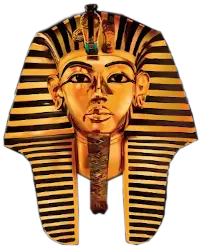
coincide with the everything and nothing, and the "all-inclusiveness" and emptiness of the Egyptian Sun God.
(ii) The similarity of names shared by the Egyptian Sun God and the atom of science:
Now, with reference to the similarity of these two names, the first thing we should bear in mind is the fact that they both possess identical attributes, as has been already pointed out in section i; and consequently we are compelled to conclude that the atom of science is the identical name of the Egyptian Sun God: the most ancient of Gods except Ptah, who was present with Atom at creation. The second thing we should bear in mind is the fact that the name of the God Atom (sometimes spelt Atum) belongs to the cosmology of the Memphite Theology, whose date goes back to 4000 B.C. when the Greeks were not even known. Consequently we are compelled to conclude that the Greeks obtained both the original name and the attributes of the Sun God Atom from the Egyptians.
Furthermore, the Greeks were unacquainted with the Egyptian language, during the period of the so-called Greek philosophy, dating from the sixth century B.C. and as a consequence transliterated Egyptian words into Greek without regard to their derivatives. The following Homeric stories verify the practice of the Greeks in the transliteration of Egyptian words and the plagiarism of their legends. (a) According to Homer, Proteus was a Maritime Divinity feeding his phocae on the coast of Egypt. He was endowed with the gift of prophecy which was exercised only upon compulsion. Proteus, however was an Egyptian Pharaoh who succeeded to the throne on the death of Pheron, the son of Sesostris. Proteus was also worshipped at Memphis. The Greeks did not only transliterate the name of this Egyptian King, but also plagiarized on the legend. (Herodotus II, 112).
(b) Likewise the story of Io the Argive Princess, who was changed into a heifer, and after long wanderings, reached
Topics
Greek Philospohy is Stolen Egyptian Philosophy
The Memphite Theology is the Basis of all Important Doctrines of Greek Philosophy
Greek Philosophy was Alien to the Greeks
Greek Philosophy was the offspring of the Egyptian Mystery System
The Egyptians Educated the Greeks
The Curriculum of the Egyptian Mystery System
The Pre-Socratic Philosophers and the teaching Ascribed to them
The Athenian Philosophers
1. Socrates
2. Plato
3. Aristotle